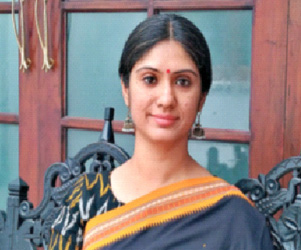
Sinu Joseph, whose ancestral roots are in Kerala, born and brought up in Bengaluru, is an educator, a writer, a counselor, all rolled into one. An engineer by qualification, she has worked on various issues in the social space over the last 6 years. She has travelled extensively across rural India interacting with more than 17,000 adolescent girls and women to really understand the practices and problems first hand. She believes in action learning and makes sure that our work is always grounded in reality. She formed ‘Mythri Speaks’ in 2014, a grass-roots voluntary organisation that focuses on women’s health all over India by focusing on developing realistic solutions and working along with the community on addressing rural issues, especially pertaining to the environment. Working with a dedicated team of individuals, the organisation has oriented thousands of rural adolescent girls and women through awareness workshops, across the states of Karnataka, Jharkhand, Bihar, Assam, Meghalaya, Manipur, and Tamil Nadu. The Animation film ‘Mythri’ on menstruation, has reached over 4 million adolescent girls in government schools. Her recent remarks on RSS and Hinduism during a seminar went viral in YouTube. In an exclusive interview to Organiser representative Pradeep Krishnan, she shared her profound thoughts on social work, RSS, Hinduvta, etc. Excerpts:
These days, generally, people after getting high academic qualification aspire for a job having a heavy pay. But you took up a unique and different route? What prompted you to take up social service?
Yes, I have a problem in working keeping only money in mind. I could never understand the logic of how money should be the primary driver. That’s why I could never take to working in the IT space; it was too dull and lifeless. Sometimes people wrongly assume that I made some sacrifice to work in the social space. It is no such thing. I thoroughly enjoy my work, and it will be an insult to call it a sacrifice. Before joining the social space, I had never really known what to do. But I was always clear about what not to do. I began by volunteering at ‘Youth for Seva’ for a few months just to see what it’s like, and after that I was offered a full-time position there. Then there was no looking back.
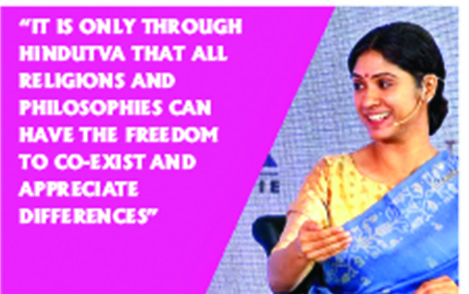
Over the last 10 years of my work in the social space, I have experienced how money is never the hurdle. We always start with a zero budget. If we have clarity about the work, funds will come. But if we start with money as the focus, neither will money come nor will we ever understand the work in depth. I consider myself lucky to have worked in the RSS eco-system, where this way of thinking is fully understood and accepted.
Tell us about all the various social projects that you have undertaken at present?
For four years, from 2009 to 2013, I worked in ‘Youth for Seva’, on an initiative called ‘Doctors for Seva’. After that, I worked independently for a while on the subject of menstruation, and later created ‘Mythri Speaks Trust’. Sometime in between, I also worked on urban waste management through The Forward Foundation. At present, I am working on Adarsha Grama Vikasa, which is a rural development initiative. However, my primary area of interest is my work on exploring the science behind cultural practices around menstruation, and understanding menstrual restrictions through indigenous science.
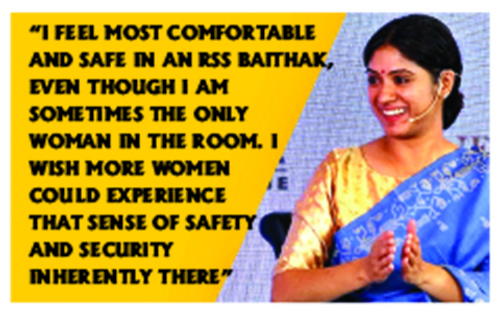
Recently, you spoke very highly of Indian culture. Tell us about what triggered you taking interest in our unique culture and civilisation?
I still remember the first time I was asked “why should we Indians take pride in our culture?” This question was posed during an orientation for the new comers in ‘Youth for Seva’. At that time, I had not fully understood what this culture really means. So, instead of answering, I asked the facilitator, “Wouldn’t I be a proud Chinese if I were born in China, or a proud Pakistani if I was born in Pakistan, and so on? How can the coincidences of being born in India, make it reason enough to take pride in our culture?” I think if this had not been the RSS eco-system, I couldn’t have gotten away with such arrogance.
What really got me to dig deeper into our culture, was my sessions on menstruation, especially when I interacted with rural adolescent girls. Very often, the questions asked by young girls would be “Why are we not allowed to go to temples when we menstruate?” or “Am I so impure that even God doesn’t accept me when I menstruate?” Such questions would put me in a fix because I knew so little about these things. For the first few years, I simply told them that it is not scientific, and that they can do what they want. But every time I said that, the girls would just go silent because unknowingly, I was telling them that their mothers and grandmothers were wrong. It took me about five years to finally accept that it cannot be superstition if millions of women even today are following it. There must be more to it that I don’t know. And so began a different journey to get to the root of it all. The next five years of my work involved interacting and learning from spiritual masters, Ayurveda practitioners and many wise men and women from across the country. But mostly, I learnt from the rural grandmothers – these women are the keepers of our culture. It is strange that a subject like menstruation, when dug deeper, can take one to the very roots of culture, science and spirituality.
Do you consider yourself a Hindu? What are the reasons?
Of course I do. Anyone who is born in this land, is first a Hindu. It is simply an unalterable fact, whether we like it or not. If you ask me, how can that question even be raised? In recent times, ‘Hinduism’ might have become a religion, and so we are all forced to decide whether or not we are a Hindu. But it is first a culture, a way of living, which by nature includes every human being born in this land. It may have taken me a while to understand this, but now that I do, it is unquestionable.
You said that you are an atheist? Why did you leave the Catholic Church or rather Christianity?
All through my school years, it was very stifling to be a Christian. One, because it necessitates one to look down upon non-Christians and two, because a prominent aspect in Christian faith is guilt. Let me share a few examples of this. In school, the Christian teachers would quietly weave in disrespect for other religions. Our history teacher would tell the class that Christianity is real because the existence of Christ is documented in history, whereas Hinduism is just mythology without historical evidence. As I entered adulthood, I noticed how if anyone went against the religion, for example by marrying a Hindu, then the family and church would go on a mission to induce guilt. I have closely seen such methods wreaking havoc on the state of mind of practising Christians, whose faith then borders on fanaticism. They reach a state where you cannot reason with them anymore, as they have lost their mental balance.
When I was about 15 or 16 years of age, I started to rebel and question everything. Since then, if someone talks to me in the context of being a Christian, my instant response is that I am an atheist. To me, it simply means that I will not accept something just because I was born into it, and certainly not if it is forced down my throat using guilt. Having said that if I am asked the same question in the context of being a Hindu, my response will be very different. In the context of being a Hindu, I am definitely not an atheist, because Hinduism doesn’t require one to believe anything that is not directly experienced. For me, experience comes before belief.
According to you, what is unique about Sanatan Dharma?
When I write about cultural practices in Hinduism, people ask why I do not write about Christianity. As a religion, Hinduism is certainly the mother of all religions, given that it encompasses all the different faiths, doctrines and theories that exist. And Sanatan Dharma is the grand mother of all philosophies. In other words, when we want to understand a subset, we must study the superset. In fact, it is through the lens of Hinduism that I was able to understand the techniques in Christianity and even appreciate why faith-based healing and prayers work for some people, when it is not twisted for socio-political reasons. As I understand, the Ultimate Truth can only be reached through a path that understands and accepts all methods, and that’s what is unique about Sanatan Dharma. Apart from that, what is rarely discussed or even understood fully, is the deep and subtle science behind the Hindu tradition. Every practice is rooted in this science. When we understand the science behind it, we can’t help but be in awe of this ancient system.
Your views on Hindutva?
Unlike the word Hinduism, which is used in the context of a religion, the word ‘Hindutva’ gives a sense of resurgence, a revival of the ancient philosophies, science and culture, that was intrinsic to this land. It is about standing firm in our understanding of our cultural and philosophical roots and not giving in to negative commentary. Is it necessary? Absolutely yes, if plurality and sense have to prevail. It is only through Hindutva that all religions and philosophies can have the freedom to co-exist and appreciate differences.
Earlier, before knowing about RSS, what made you fear the RSS and how that idea crept in to your mind?
These ideas creep in, in a very subconscious way. Somewhere along the way, my Christian upbringing taught me to stay away from other religion-based organisations. The thought process was that RSS is a fanatic organisation that aims to dissolve all minority religions. I remember when people in my family had to vote, they would discuss how it doesn’t matter who they vote for as long as it is not BJP. Somehow, many Christians feel their very survival is at risk as long as there is RSS. Of course, I now know that if Christians are having a peaceful existence in India, it is because of the accepting nature of the RSS and Hinduism.
Recently, you openly spoke very highly about the RSS, the organisation often ridiculed by so-called secularists and the Left? What are your views on RSS and its sister organisations?
I don’t think I am qualified enough to comment on the depth of the idea that is the RSS. Whatever little I know is through my experience of working with people from the RSS. So, you can say that my knowledge is very limited to my experience as an individual and as a woman, who unknowingly walked into the RSS ecosystem. Just to give a background to what I am about to say…. where I came from, violence on women is not uncommon or unusual. When women go through such situations for long periods of time, we either become meek and suppressed or utterly ferocious. For me, it was the latter. So, it was with claws extended and ruffled feathers that I stumbled upon the RSS. Before I got to know men from RSS, I instinctly resented men in positions of authority. It was, therefore, a very big surprise, to experience kindness from men in RSS. I did not expect it. Within the RSS eco-system, I found that women are treated with so much gentleness and respect. The idea of raising a hand on women is unthinkable for them. Just by virtue of being a woman, you are treated with respect. This was such a stark contrast to my personal experiences outside the RSS that it forced me to revisit whatever I had heard about the RSS and the accusations of patriarchy. Even today, I feel most comfortable and safe in an RSS baithak, even though I am sometimes the only woman in the room. I wish more women could experience that sense of safety and security that is inherently there within the RSS ecosystem.
The other stunning discovery I made was how open the RSS is to opposing points of view, and how it encourages people to question. In the first few years of my work with RSS based organisations, I questioned everything. I was deeply moved by the way in which the questions (sometimes accusatory) were received. Not once was I told not to question. Not once did they dodge any question. And never was I treated as an outsider or with disrespect. The gentle way in which they deal with people, forces even the wild ones like me to become mild! I don’t think that there are too many other groups out there which are so genuinely open, kind and welcoming of opposing views. Apart from those who have a planned agenda to malign the RSS, most people who misunderstand the RSS are often those who have never really worked within the organisation, and have little or no direct experience of it. It’s a bit of a chicken-egg situation where they never understand the RSS because they are not open to working with the RSS; and unless they work within RSS, they will never understand it.
In one of your articles, you wrote “How the Chengannur Bhagavathy Temple shifted my menstrual cycle?” Could you please narrate that experience?
Yes, it was one of those experiences which opened up a whole new dimension of understanding to what Hindu temples are all about and how they can directly impact our physiology. I have written about it in detail in my upcoming book, with a deeper understanding of the science behind it. Rather than narrate it here in a limited space, I would encourage women to visit the Bhagavathi Temple in Chengannur (Kerala) and experience how it alters the menstrual cycle to bring it in alignment with the larger cycles of nature. Many women devotees who visit this temple will narrate how their menstrual and/or fertility problems get resolved after visiting this temple. This isn’t the only such temple. There are many temples in India where fertility Goddess are worshipped, and they have a similar impact on the menstrual cycles. I have experienced it significantly in Kamakhya Temple in Assam, and also in Lepakshi Temple where Durga Maa is only in a corner of the temple, but her presence is very dominant. This is the reason why women who traditionally visit temples often and follow the menstrual restrictions actually have a better menstrual and reproductive health. It is not just faith. It is science working at the meta physical level.
Can visiting temples affect menstruating women? What are your views on the Sabarimala temple issue?
Yes, visiting temples during menstruation can badly affect women’s menstrual and reproductive health. Sabarimala is a good example to understand how such spaces impact women’s health. But unfortunately, no one is talking about it in such terms. We are simply going in circles talking about equality and women’s rights, when the reality is about women’s health. In 2016, I had interviewed Smt. Devika Devi who is the mother of the then Thantri of Sabarimala. In her quiet voice she told me that the reason why women are restricted from going to Sabarimala is because it negatively impacts their health. But her voice was hardly heard, as men took over the conversation and made it all about a celibate deity not wanting women to come near Him. Such conversations are insulting to both women and the deity, who is beyond all such discrimination. I learnt from Shri Aravind Subramanyam’s work that Sabarimala is not one temple in isolation, it is part of the Shat Chakras and there are five temples which must be visited in a specific order before visiting Sabarimala. I have visited the Shat Chakra temples (except Sabarimala) associated with Shastha and will be writing about my experience in each of these temples, in my upcoming book. Each of these temples work on one of the chakras, from Muladhara to Aajna, with Sabarimala being the Aajna Chakra. This entire exercise is the process for those who chose the Nivritti Marg, the path of renunciation. The impact of this on men is very different from the impact on women, both emotionally and physically.
As I visited each of these temples, I realised how differently such a path can impact women in the menstruating age. Emotionally, when women chose to go on this path, they will naturally develop Vairagya and become distanced from their familial and societal responsibilities; the pull towards Lord Ayyappa and devotion to Him would dominate all other emotions. Physically, for women who are in the menstruating age, such a path can cause severe menstrual and reproductive disorders.
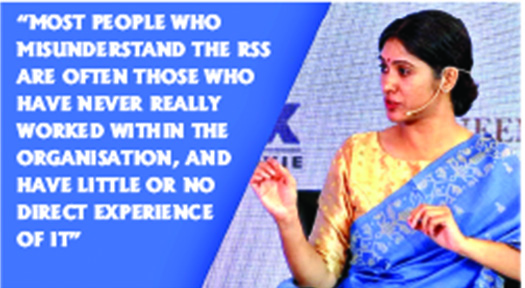
While the so-called Left intellectuals vehemently argue that Manu Smriti is responsible for all that is bad/wrong in Indian society, you say that Manu Smruti can tackle the increasing incidence of sexual crime?
Works like Manu Smruti will never become irrelevant, no matter how old a text it is, for the simple reason that it is written by those who thoroughly understood the human nature and mind. If we have to properly understand this text today, two things are a must – one, we must be absolutely honest about sexuality; two, we must have a clear grasp of how the human mind works. For example, sexual crimes always begin from the mind. This means that we have a window of opportunity to prevent the crime, provided we know how to restrain the mind. This restraining of the mind is what Yoga and Brahmacharya is about. But only a limited number of men will even have the discipline to follow such paths. What about the rest? Therefore, for the common man, Manu Smruti had made a list of to do’s and not-to-do’s, knowing fully well how the mind is a monkey that needs to learn restraint. In this context, when we read what Rishi Manu writes as code of conduct for men to follow regarding their behaviour with women, everything will make sense.
Do you think ancient Indian knowledge systems in different fields are relevant to the modern age? How can we make it useful?
If there is one thing I really regret not seeing enough of, it is the promotion of our native science like Ayurveda, Yoga, Mudra, Chakras and Tantra. We give so much push for getting our history right, but not even 1/10th of that effort goes into getting our science right. Whenever efforts are made, it is to reduce our science in the name of Integrated Medicine. So Ayurveda gets insultingly reduced to herbal medicines, when it is the life science that teaches us how the body can heal itself without any medicine. Yoga gets reduced to twisting and turning the body, when it is the most effective path for the Ultimate Union. Mudras get defined as hand gestures that seem to only have a decorative purpose, as we see in Delhi airport. Chakras and Tantra are not even spoken of, for fear of it being misunderstood. Temples are only known as places of transactional prayer, when it is an energy vortex that can completely alter one’s physiology, in a very scientific manner. This neglect of our sciences is a very sad state. Without understanding our sciences, we can never fully understand our culture. This lack of scientific know-how is why our cultural practices get reduced to a belief system or worse, get dismissed as superstition. Just as we are attempting to introduce various aspects of our history in the education curriculum, we also need to introduce these indigenous sciences at the school itself.


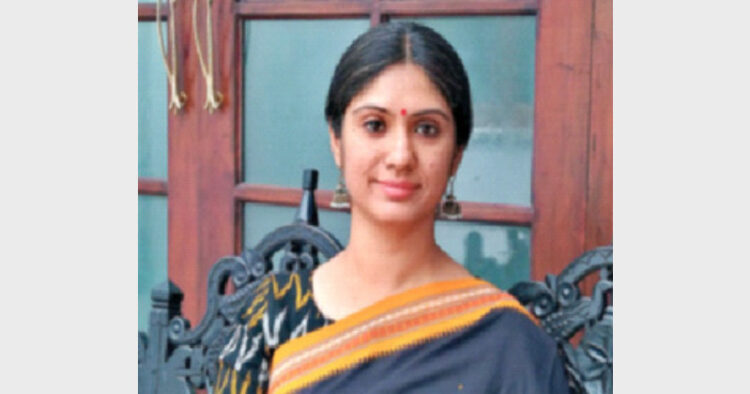
















Comments